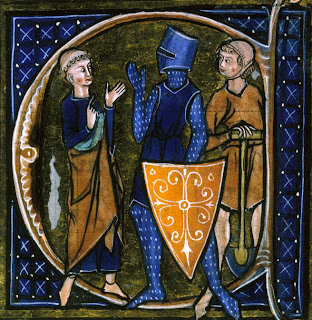Following on my discussion of OD&D AC yesterday, here is how to use OD&D attack ranks with the d20 SRD armor system (which uses armor class as target number, also known as ascending AC).
| Rank | Weak (Magic-user) | Average (Cleric, Thief) | Strong (Fighter) | Attack Bonus |
|---|---|---|---|---|
|
1
|
levels 1-5
|
levels 1-4
|
levels 1-3
|
+0
|
|
2
|
levels 6-10
|
levels 5-8
|
levels 4-6
|
+2
|
|
3
|
levels 11+
|
levels 9-12
|
levels 7-9
|
+5
|
|
4
|
levels 13+
|
levels 10-12
|
+7
|
|
|
5
|
levels 13-15
|
+9
|
||
|
6
|
levels 16+
|
+12
|
NOTES
Read the table like: clerics of levels 9 through 12 have attained attack rank 3 and have a base attack bonus of +5.
Again we see the power of three at work here. Weak, average, and strong fighting capabilities are enough to distinguish the classes from each other. Other than a category for not progressing at all, I can’t see any finer granularity adding much value to gameplay.
I have capped the progression of the weak and average classes. It should be obvious how to extrapolate the progression if you want it to be unlimited for all classes. I prefer that the pinacle of fighter combat achievement be higher than other classes.
Yes, it’s a table lookup, but it’s offline, not during the game, so who cares?
Simplified d20 SRD armor bonuses:
| Armor | AC Bonus | Penalty | Exploration | Tactical |
|---|---|---|---|---|
|
light (leather)
|
+2
|
0
|
120′
|
40′
|
|
medium (chain)
|
+4
|
-4 (-20%)
|
90′
|
30′
|
|
heavy (plate)
|
+6
|
-6 (-30%)
|
60′
|
20′
|
|
shield
|
+1
|
-1 (-5%)
|
N/A
|
N/A
|
The really cool thing about this is that there are only 24 different possibilities to remember, and all of them are distinct. So players could potentially use whatever interface they prefer, and it would be all the same to me. So, all are equivalent: I hit plate, or I hit AC 3, or I hit AC 16 (my notes generally use the “AC as plate” form).
The penalty is for ability checks and thief abilities. This is taken directly from the d20 SRD, but the numbers work with the original game, so why not? The movement rates are the same as in this encumbrance system, just presented in a slightly different form.
| Armor | Descending AC | Ascending AC |
|---|---|---|
|
Unarmored
|
9
|
10
|
|
Shield
|
8
|
11
|
|
Leather
|
7
|
12
|
|
Leather & shield
|
6
|
13
|
|
Chain
|
5
|
14
|
|
Chain & shield
|
4
|
15
|
|
Plate
|
3
|
16
|
|
Plate & shield
|
2
|
17
|
I’m sure you have seen similar tables to this before, but I include this one here to show the minimum knowledge I need to keep in my head. You’ll also notice that the ascending AC column above is identical to the first OD&D combat rank.





